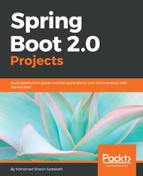Let's have a look at the article/create.ftl page, which implements the Create Article page and makes use of the common template shown in the preceding section's code:
<#import "../common/standardPage.ftl" as p>
<@p.page title="${(article.title)!'New Post'}">
<script type="text/javascript" src="/webjars/ckeditor/4.7.0/standard/ckeditor.js"></script>
The preceding code imports the CKEditor JavaScript library to enable rich text writing for the content section:
<!-- Post Content Column -->
<div class="col-lg-8">
<form action="/article" method="post">
The preceding code creates a form that can be submitted to a URL/article as a POST request to create or update a blog article:
<#if article?? >
<input type="hidden" id="id" name="id" value="${article.id}"/>
<div class="form-group">
<label for="postTitle">Title</label>
<input type="text" class="form-control" id="title" name="title"
placeholder="Post Title" value="${article.title}" required="true">
</div>
<div class="form-group">
<label for="postLink">Perma Link</label>
<input type="text" class="form-control" id="link" name="link"
placeholder="Post Perma Link" value="${article.link}"
required="true">
</div>
<div class="form-group">
<label for="postSummary">Summary</label>
<textarea class="form-control" id="summary" name="summary" rows="3"
required="true">${article.summary}</textarea>
</div>
<div class="form-group">
<label for="postBody">Body</label>
<textarea class="form-control" id="body" name="body" rows="10"
required="true">${article.body}</textarea>
</div>
If an article is already there (update article scenario) then the preceding code will store the ID of that article in a hidden field to be submitted and will populate the Title, Perma Link, Summary, and Body with the existing values so that they can be edited, shown as follows:
<#else>
<div class="form-group">
<label for="postTitle">Title</label>
<input type="text" class="form-control" id="title" name="title"
placeholder="Post Title" required="true">
</div>
<div class="form-group">
<label for="postLink">Permalink</label>
<input type="text" class="form-control" id="link" name="link"
placeholder="Post Permalink" required="true">
</div>
<div class="form-group">
<label for="postSummary">Summary</label>
<textarea class="form-control" id="summary" name="summary" rows="3"
required="true"></textarea>
</div>
<div class="form-group">
<label for="postBody">Body</label>
<textarea class="form-control" id="body" name="body" rows="10"
required="true"></textarea>
</div>
</#if>
<div class="form-group">
<input class="form-control btn btn-primary" type="submit"
value="Save"/>
</div>
If it is an entirely new article then the preceding code will create empty Title, Perma Link, Summary, and Body fields. Eventually, the page will have a Save button for both the create and update use cases:
<script type="text/javascript">
CKEDITOR.replace( 'body' );
$("#title").keyup(function(){
var str = $(this).val();
str = str.replace(/[^a-zA-Z0-9s]/g,"");
str = str.toLowerCase();
str = str.replace(/s/g,'-');
$("#link").val(str);
});
</script>
</form>
</div>
</@p.page>
For styling, the body section with bold, italic, and so on, on a fully fledged JavaScript editor named CKEDITOR is used. The following dependency in pom.xml is required to enable that:
<dependencies>
...
<dependency>
<groupId>org.webjars</groupId>
<artifactId>ckeditor</artifactId>
<version>4.7.0</version>
</dependency>
</dependencies>
The following JavaScript code in the front-end page can be used to enable CKEDITOR on an HTML element:
<script type="text/javascript">
CKEDITOR.replace( 'body' );
...
</script>
This page also makes use of the common template. It also has a piece of jQuery JavaScript code that takes the text typed in for the title and converts it into a permanent link URL by replacing spaces with '-' and rendering all other characters in a simple case.
